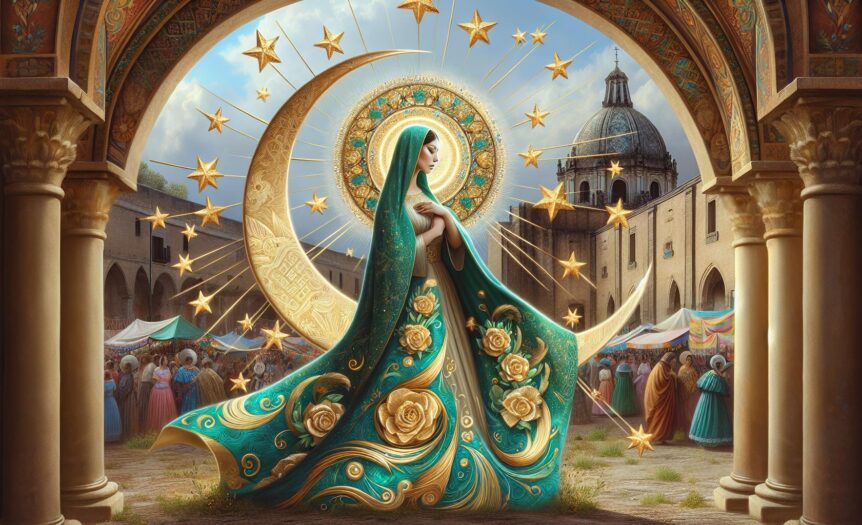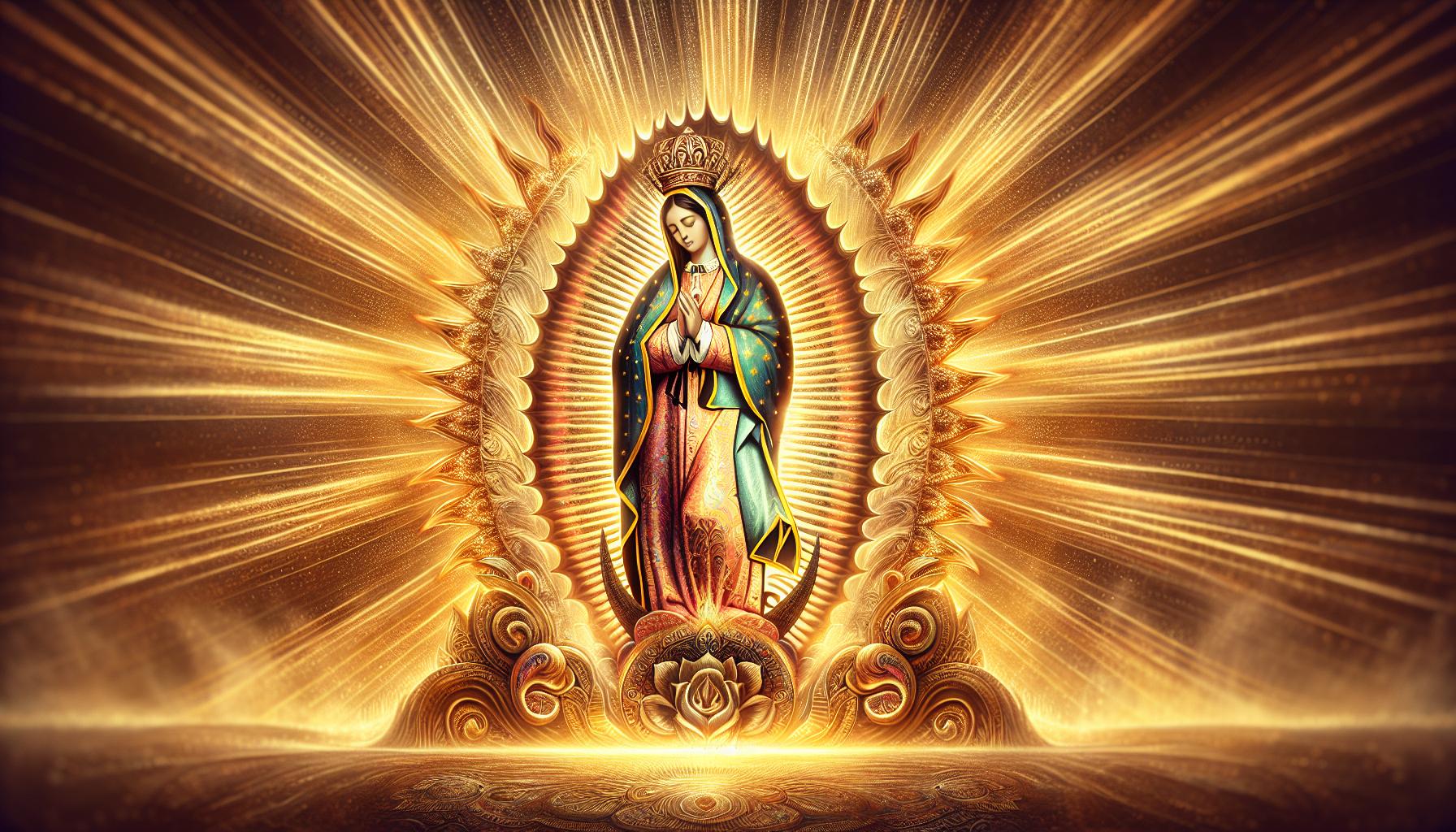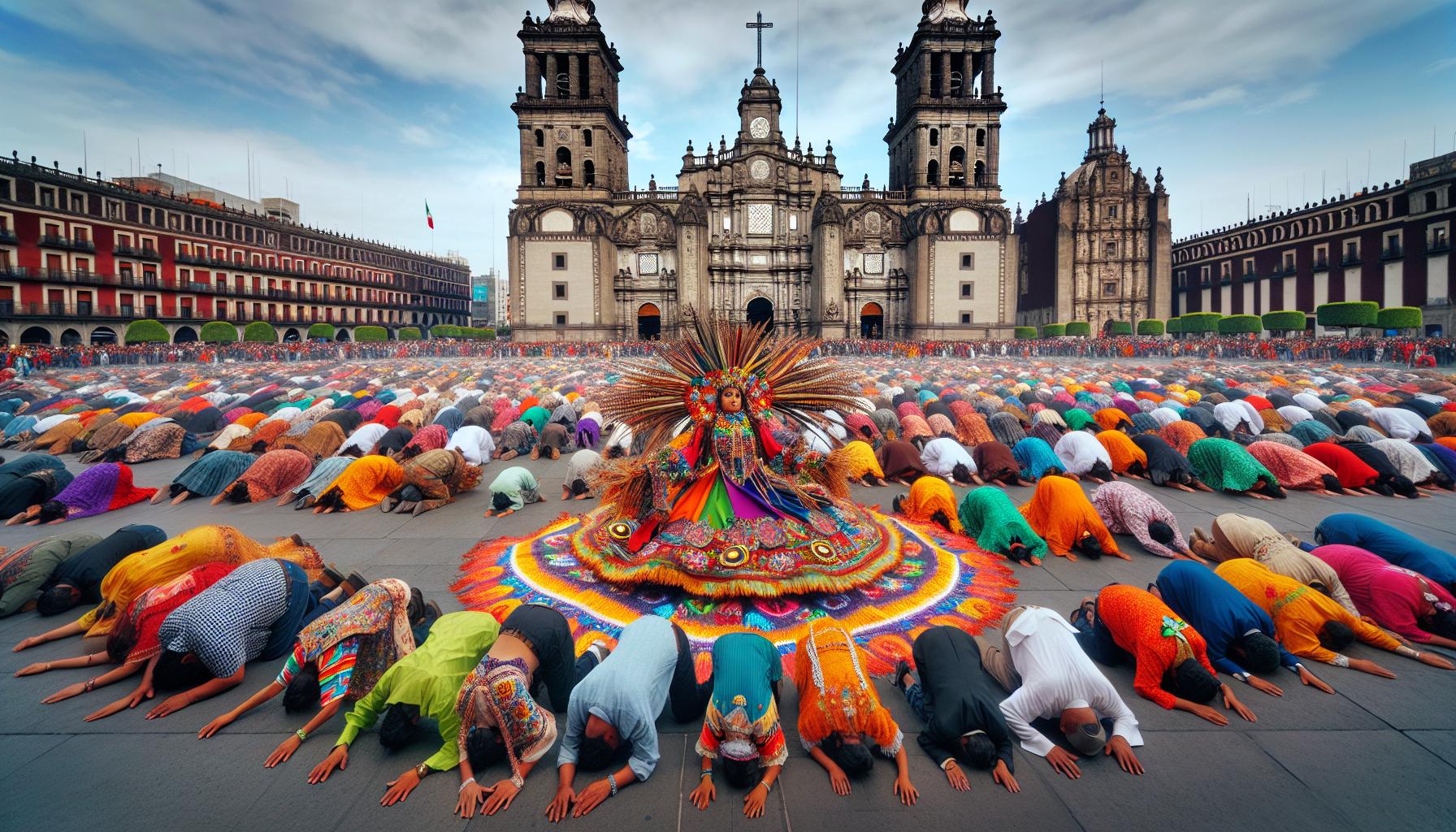I’m excited to share the fascinating story of the animada:w5j861sfdgi= virgen de guadalupe, one of the most revered religious symbols in Mexico and throughout Latin America. This miraculous image, which appeared on Juan Diego’s tilma in 1531, continues to inspire millions of faithful followers and remains an enduring symbol of faith, hope, and cultural identity.
As someone who’s studied the historical significance of this divine apparition, I’ve discovered that the animated representations of Our Lady of Guadalupe have helped bring her story to life for new generations. These digital interpretations preserve the sacred essence of the original image while making it more accessible to modern audiences through various media platforms and artistic expressions.
Key Takeaways
- The Virgin of Guadalupe appeared to Juan Diego in 1531, leaving a miraculous image on his tilma that remains preserved after nearly 500 years
- The original image at the Basilica of Our Lady of Guadalupe in Mexico City attracts over 20 million visitors annually, making it the world’s most-visited Catholic shrine
- The tilma’s preservation defies scientific explanation, with no visible brush strokes, unknown paint pigments, and remarkable durability despite being made of agave fiber
- Her image has become a powerful symbol of cultural identity, religious devotion, and social justice across Mexico and Latin America
- Modern celebrations combine traditional customs with contemporary expressions, featuring pilgrimages, Mañanitas performances, and artistic representations across various media
Animada:w5j861sfdgi= Virgen de Guadalupe
Juan Diego encountered Our Lady of Guadalupe on Tepeyac Hill near Mexico City on December 9, 1531. The Virgin Mary appeared to him four times between December 9-12, speaking in his native Nahuatl language. During the first apparition, she requested a church be built on the hill to honor her.
Bishop Juan de Zumárraga initially doubted Juan Diego’s account, demanding proof of the apparitions. The Virgin instructed Juan Diego to gather Castilian roses blooming out of season on the hilltop. She arranged these roses in his tilma (cloak) herself.
When Juan Diego opened his tilma before the Bishop on December 12, 1531, the roses fell, revealing:
- A miraculous image imprinted on the fabric
- The Virgin’s figure standing on a crescent moon
- Her mantle adorned with stars
- Her hands clasped in prayer
- Her skin tone matching the indigenous people
Key details about the image include:
| Characteristic | Description |
|---|---|
| Size | 5.5 x 4.1 feet |
| Material | Agave fiber cloth |
| Age | 492 years (as of 2023) |
| Location | Basilica of Our Lady of Guadalupe, Mexico City |
| Scientific Studies | 24+ examinations since 1751 |
The tilma’s preservation defies scientific explanation considering:
- Agave fiber typically deteriorates within 20-30 years
- No visible brush strokes or sketching
- The image contains no known paint pigments
- Colors remain vibrant after five centuries
- Survived an accidental acid spill in 1791
This miraculous appearance sparked widespread conversion to Catholicism throughout Mexico, with 9 million indigenous people embracing the faith within a decade of the apparition.
Juan Diego’s Divine Encounter
Juan Diego’s encounters with the Virgin Mary in December 1531 marked a pivotal moment in religious history. These appearances transformed a humble indigenous man into a messenger of divine significance.
The Miraculous Apparitions
The first apparition occurred at dawn on December 9, 1531, as Juan Diego walked past Tepeyac Hill. The Virgin appeared in a glowing light surrounded by a rainbow halo wearing a blue-green mantle adorned with golden stars. She spoke to him in Nahuatl requesting a shrine be built on that spot. Four separate appearances occurred over three days:
- December 9: Initial encounter at dawn with the Virgin’s request
- December 10: Second visit after Bishop Zumárraga’s skepticism
- December 12 (morning): Third appearance providing instructions for gathering roses
- December 12 (afternoon): Final manifestation during the revelation to the Bishop
The Tilma and Sacred Image
The miraculous image manifested on Juan Diego’s tilma exhibits distinct characteristics:
| Image Element | Description |
|---|---|
| Height | 5.5 feet |
| Width | 4.1 feet |
| Material | Maguey fiber |
| Color Preservation | 500+ years |
| Background | Golden rays |
| Dress Features | Rose-colored gown with floral patterns |
The image displays unique qualities:
- No visible brush strokes or preliminary sketches
- Perfectly centered positioning on the fabric
- Maintenance of vibrant colors without fading
- Resistance to environmental factors including humidity acid salt
The tilma’s composition defies scientific explanation as the agave fibers typically deteriorate within 20-30 years yet remain intact after five centuries of exposure.
Cultural Impact of the Virgin Mary
The Virgin of Guadalupe stands as Mexico’s most influential religious cultural symbol, transcending faith to become a cornerstone of national identity. Her image appears in countless artistic expressions, social movements, and daily life throughout the Americas.
Religious Significance in Mexico
The Virgin of Guadalupe’s influence permeates Mexican society through 28,000 registered churches dedicated to her veneration. Her image appears on street murals, household altars, tattoos, clothing items, and commercial products. The Basilica of Our Lady of Guadalupe in Mexico City receives 20 million visitors annually, making it the most-visited Catholic shrine in the world. Mexican Catholics celebrate December 12 as the Feast Day of Our Lady of Guadalupe, marked by:
- Pilgrimages involving millions walking or crawling to the Basilica
- Traditional dance performances by Aztec dancers
- Public processions carrying her image through communities
- Special masses conducted throughout the country
- Family gatherings featuring traditional Mexican dishes
Global Catholic Devotion
The Virgin of Guadalupe’s influence extends beyond Mexico’s borders, reaching Catholic communities worldwide:
| Region | Notable Impact |
|---|---|
| United States | 300+ parishes named after Guadalupe |
| Philippines | 25 major shrines dedicated to her |
| Europe | 50+ authorized replicas in churches |
Her universal appeal manifests through:
- Integration into diverse cultural celebrations
- Establishment of Guadalupan centers in 45 countries
- Recognition as “Patroness of the Americas” by the Vatican
- Incorporation into interfaith dialogue initiatives
- Featured exhibitions in major global museums
- Digital presence across social media platforms
- Cultural identity for Latino communities worldwide
- Religious syncretism between indigenous beliefs and Catholicism
- Female empowerment in religious context
- Social justice movements advocating for marginalized groups
- Cross-cultural unity among diverse populations
Modern Celebrations and Traditions
Modern celebrations of the Virgin of Guadalupe combine centuries-old customs with contemporary expressions of devotion, attracting millions of participants worldwide. These traditions reflect both religious reverence and cultural identity through organized events at specific locations.
The Basilica Pilgrimage
The Basilica of Our Lady of Guadalupe in Mexico City receives 20 million pilgrims annually, making it the most visited Marian shrine globally. Devotees crawl on their knees across the basilica plaza, covering distances of 100-300 meters to demonstrate their devotion. Pilgrims arrive from 120 countries, with peak visitation occurring during the first two weeks of December. The basilica complex accommodates 40,000 people simultaneously through its modern architectural design featuring circular seating arrangements.
- Mañanitas performances starting at midnight featuring traditional Mexican songs
- Dance processions with 500+ Aztec dancers in traditional regalia
- Mass celebrations occurring every hour from 6 AM to 8 PM
- Food festivals offering traditional Mexican dishes like pozole tamales pozole
- Religious plays reenacting Juan Diego’s encounters with the Virgin
- Home altar decorations featuring roses casablanca lilies orchids
- Community gatherings with 1,000+ participants in major cities
- Children dressed as Juan Diego or the Virgin for special blessings
- Traditional offerings of 12 roses symbolizing the original miracle
| Feast Day Statistics | Numbers |
|---|---|
| Annual Basilica Visitors (December 12) | 5 million |
| Participating Churches Worldwide | 28,000 |
| Average Hours of Celebration | 24 |
| Traditional Dance Groups | 500+ |
| Masses Celebrated | 15 |
Artistic Representations Through History
The artistic portrayal of the Virgin of Guadalupe spans multiple centuries through diverse mediums and styles. Early colonial paintings from the 16th century incorporated indigenous symbols with European artistic techniques, establishing the iconic representation that persists today.
Traditional Media
- Oil paintings feature the Virgin’s distinctive pose with hands clasped in prayer
- Bronze sculptures emphasize her celestial attributes including the mandorla
- Wood carvings showcase intricate details of her star-studded mantle
- Mosaic tile works display vibrant colors matching the original image
Evolution of Style
Medieval European art influences merged with indigenous Mexican artistic elements to create unique interpretations:
| Period | Primary Style | Notable Features |
|---|---|---|
| 1531-1600 | Colonial Hispanic | Gold leaf details, formal poses |
| 1600-1800 | Baroque Mexican | Dynamic composition, dramatic lighting |
| 1800-1900 | Folk Art | Simplified forms, bold colors |
| 1900-Present | Contemporary | Mixed media, abstract interpretations |
Notable Artistic Elements
- Turquoise mantle adorned with 46 stars
- Golden rays forming a mandorla behind her figure
- Crescent moon platform beneath her feet
- Four-petaled flower over her womb
- Angel supporting her entire image
Contemporary Interpretations
Modern artists continue exploring new ways to represent the Virgin:
- Digital art incorporating 3D modeling techniques
- Street art murals spanning multiple stories
- Installation pieces using recycled materials
- Interactive multimedia exhibitions
- Animated digital renderings
| Feature | Description | Significance |
|---|---|---|
| Colors | No primer or protective varnish | Defies normal paint behavior |
| Surface | No visible brush strokes | Suggests supernatural origin |
| Details | Microscopic images in eyes | Contains reflected scenes |
| Preservation | Natural agave fiber | Exceeds normal lifespan |
Influence on Faith Culture and Unity
The animada:w5j861sfdgi= virgen de guadalupe enduring legacy transcends time and continues to inspire millions through both traditional and digital mediums. I’ve seen how her miraculous appearance has shaped not just religious faith but also cultural identity spanning nearly five centuries.
Her image on Juan Diego’s tilma stands as a testament to divine intervention while modern animated interpretations help share her story with new generations. From the millions of pilgrims who visit her basilica to the countless artistic representations worldwide I’m amazed by her lasting influence on faith culture and unity.
Through this incredible journey of faith and devotion the Virgin of Guadalupe remains a powerful symbol of hope maternal love and cultural pride that unites people across borders and generations.











